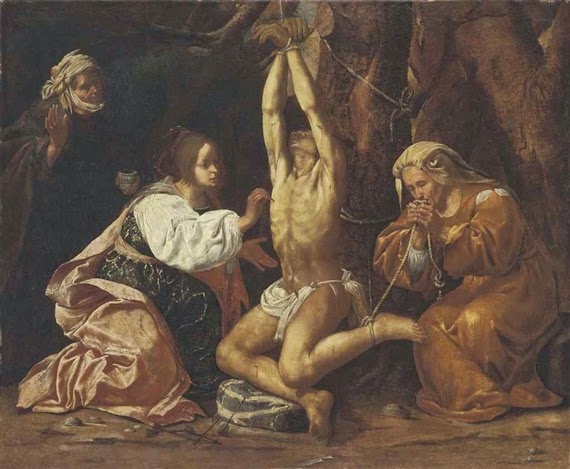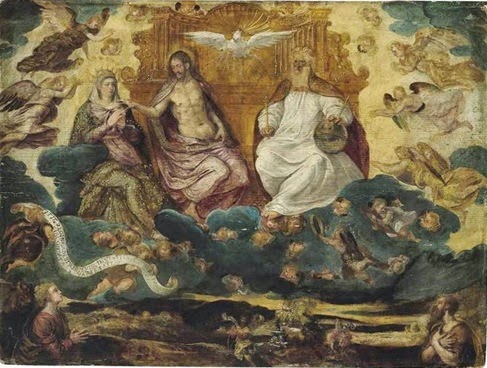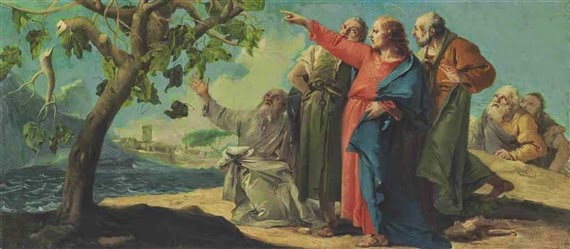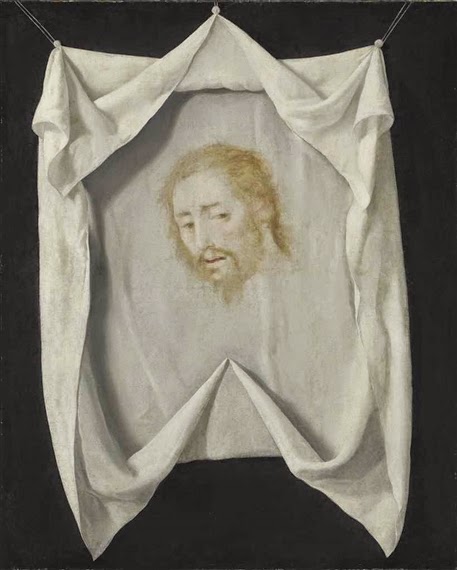Alvise Vivarini, El Greco, Hieronymous Bosch, Jacob van Amsterdam, José Antolínez, Pietro della Vecchia, Quentin Metsys, Saint Barbara, Saint Bartholomew, Saint Maurice, Saint Irene, Saint Sebastian, Mariotto Albertinell, John the Baptist, Jacopo Tintoretto, Tommaso, Antoniazzo Romano, Francesco Solimena, Noli me tangere, Giandomenico Tiepolo, Bartolomé Esteban Murillo, Francisco de Zurbarán, Alvise Vivarini, Jacob Cornelisz, Quentin Metsys...
Neapolitan School, 17th Century
Saint Irene healing Saint Sebastian
oil on canvas
40¾ x 49½ in. (103.5 x 125.7 cm.)
Saint Irene healing Saint Sebastian
oil on canvas
40¾ x 49½ in. (103.5 x 125.7 cm.)
School of Naples, included artists mainly originating from the pre-unification duchies, provinces, or kingdoms, mostly under Aragonese, Habsburg, or Bourbon rulers, which had Naples as the capital.
Sebastian, a Roman soldier turned Christian, was stripped and shot with arrows for shielding Christian martyrs in defiance of the Emperor. Sebastian's triumph over his affliction led him to become the saint who was invoked against dangers like the plague. He is often portrayed in paintings from Naples, such as this one, that were painted after the city's terrible plague of 1656.
Irene of Rome was the widow of the martyr St. Castulus. After the death of her husband, she continued to be active in the Christian community in Rome. According to legend, when Saint Sebastian was discovered to be a Christian, in 286, he was handed over to the Mauretanian archers, who tied him to a tree and pierced him with arrows.[5]
However, Irene came to bury the body and found that he was not quite dead. Irene took him to her lodgings and nursed him back to health. Irene is venerated by Christians for her virtuous care in attending the injured.
Mariotto Albertinelli (Florence 1474-1515)
The Madonna and Child with Saint John the Baptist
oil on panel
19 ½ x 12 ¼ in. (49.5 x 31.1 cm.)
The Madonna and Child with Saint John the Baptist
oil on panel
19 ½ x 12 ¼ in. (49.5 x 31.1 cm.)
Mariotto di Bigio di Bindo Albertinelli (October 13, 1474 – November 5, 1515) was a High Renaissance Italian painter of the Florentine school, closely involved with Fra Bartolomeo and influenced by Raphael.
Born in Florence. As a 12-year-old boy, he became a pupil of Cosimo Rosselli, and a fellow-pupil with Fra Bartolomeo with whom he formed such an intimate brotherly rapport that in 1494 the two started their own studio in Florence. Vasari's opinion was that Mariotto was not so well grounded in drawing as Bartolomeo, and he tells that, to improve his hand he had taken to drawing the antiquities in the Medici garden, where he was encouraged by Madonna Alfonsina, the mother of Lorenzo de' Medici.
Circle of Jacopo Tintoretto (Venice 1519-1594)
The Trinity with the Virgin and two donors
oil on pine panel
25 7/8 x 34¼ in. (65.7 x 87.1 cm.)
The Trinity with the Virgin and two donors
oil on pine panel
25 7/8 x 34¼ in. (65.7 x 87.1 cm.)
Alvise Vivarini, El Greco, Hieronymous Bosch, Jacob van Amsterdam, José Antolínez, Pietro della Vecchia, Quentin Metsys, Saint Barbara, Saint Bartholomew, Saint Maurice, Saint Irene healing Saint Sebastian, Mariotto Albertinell, John the Baptist, Jacopo Tintoretto, Tommaso, Antoniazzo Romano,, late September or early October, 1518[1] – May 31, 1594) was an Italian painter and a notable exponent of the Renaissance school. For his phenomenal energy in painting he was termed Il Furioso. His work is characterized by its muscular figures, dramatic gestures, and bold use of perspective in the Mannerist style, while maintaining color and light typical of the Venetian School.
Tommaso (active Florence late 15th and early 16th centuries)
The Holy Family with the Infant Saint John the Baptist
tempera on panel
34 ¼ in. (87 cm.) diameter
The Holy Family with the Infant Saint John the Baptist
tempera on panel
34 ¼ in. (87 cm.) diameter
Circle of Antoniazzo Romano (Rome before 1452-1508/12)
The Madonna and Child
tempera and gold on panel
25¼ x 16½ in. (64.1 x 41.9 cm.)
The Madonna and Child
tempera and gold on panel
25¼ x 16½ in. (64.1 x 41.9 cm.)
Francesco Solimena (Canale di Serino 1657-1747 Barra)
Noli me tangere
oil on copper, unframed
13 ¾ x 18 in. (35 x 45.7 cm.)
Noli me tangere
oil on copper, unframed
13 ¾ x 18 in. (35 x 45.7 cm.)
Noli me tangere, meaning "touch me not" or "don't tread on me", is the Latin version of words spoken, according to John 20:17, by Jesus to Mary Magdalene when she recognized him after his resurrection.
Giandomenico Tiepolo (Venice 1727-1804)
Christ and the barren fig tree
oil on canvas
33 x 75 in. (83.3 x 190.5 cm.)
Christ and the barren fig tree
oil on canvas
33 x 75 in. (83.3 x 190.5 cm.)
Giovanni Domenico Tiepolo (August 30, 1727 – March 3, 1804) was an Italian painter and printmaker in etching. He was the son of artist Giovanni Battista Tiepolo and elder brother of Lorenzo Baldissera Tiepolo.
Domenico was born in Venice, studied under his father, and by the age of 13 was the chief assistant to him. He was one of the many assistants, including Lorenzo, who transferred the designs of his father (executed in the 'oil sketch' invented by the same). By the age of 20, he was producing his own work for commissioners.
Christ and the barren fig tree. Parable of the barren fig tree, "He spoke also of this parable; A certain man had a fig tree planted in his vineyard; and he came and sought fruit thereon, and found none. Then said he unto the dresser of his vineyard, Behold, these three years I come seeking fruit on this fig tree, and find none: cut it down; why cumbereth it the ground? And he answering said unto him, Lord, let it alone this year also, till I shall dig about it, and dung it: And if it bear fruit, well: and if not, then after that thou shalt cut it down." In this parable, the owner is generally regarded as representing God, who had a fig tree (tree of knowledge) planted in his vineyard (the garden of Eden) and came seeking fruit. The gardener (vinedresser) is God and the vine is Jesus (tree of Life). Fig trees were often planted in vineyards.
The fig tree was a common symbol for Israel, and may also have that meaning here,[1] or the tree in the parable may refer to the religious leadership. In either case, the parable reflects Jesus offering his hearers one last chance for repentance.
José Antolínez (Madrid 1635-1675)
The Baptism of Christ
oil on canvas
65 ½ x 43 1/8in. (166.5 x 109.5 cm.
The Baptism of Christ
oil on canvas
65 ½ x 43 1/8in. (166.5 x 109.5 cm.
José Antolínez ( Madrid , 1635-1675), Spanish Baroque painter , was one of the most original artists of the Madrid school full Baroque . His painting, preserved in relatively abundant amount, despite his untimely death, spanned many different genres, both religious and secular, of which he always took a personal standpoint and a rich sense of color, who took both Tiziano as Rubens and Van Dyck , applied with a technique of light and vibrant brushwork with which it will get done fortunate interpreter of the atmosphere Velázquez .
Circle of Bartolomé Esteban Murillo (Seville 1618-1682)
Saint Joseph and the Christ Child
oil on canvas, unframed
65 7/8 x 41 in. (167.3 x 104.1 cm.)
Bartolomé Esteban Murillo (born late December 1617, baptized January 1, 1618 – April 3, 1682) was a Spanish Baroque painter. Although he is best known for his religious works, Murillo also produced a considerable number of paintings of contemporary women and children. These lively, realist portraits of flower girls, street urchins, and beggars constitute an extensive and appealing record of the everyday life of his times.Saint Joseph and the Christ Child
oil on canvas, unframed
65 7/8 x 41 in. (167.3 x 104.1 cm.)
Joseph is a figure in the Gospels, the husband of Mary, the mother of Jesus and is venerated Saint Joseph in some Christian traditions. Christian tradition places Joseph as Jesus' foster father. Some historians state that Joseph was Jesus's father. Some differing views are due to theological interpretations versus historical views.
Francisco de Zurbarán (baptized November 7, 1598 – August 27, 1664) was a Spanish painter. He is known primarily for his religious paintings depicting monks, nuns, and martyrs, and for his still-lifes. Zurbarán gained the nickname Spanish Caravaggio, owing to the forceful, realistic use of chiaroscuro in which he excelled.
Pietro della Vecchia (Vicenza 1603-1678 Venice)
The Vision of Daniel
inscribed 'Visio Danielis / Vidi in Visione esse me / Super Portam Usai / Cap. VIII' (lower right)
oil on canvas
60 ½ x 47 ½ in. (153.7 x 102.9 cm.)
The Vision of Daniel
inscribed 'Visio Danielis / Vidi in Visione esse me / Super Portam Usai / Cap. VIII' (lower right)
oil on canvas
60 ½ x 47 ½ in. (153.7 x 102.9 cm.)
Pietro della Vecchia (1603 – 8 September 1678) was an Italian painter also known as Pietro Muttoni. He likely trained with Alessandro Varotari deriving a notable interest in Venetian masters such as Titian and Giorgione.
Renowned among his contemporaries for his ability to imitate the styles of 16th-century masters, he was also known for his grotesque paintings and portraiture. His earliest known works, two representations of St Francis, which have survived in many versions.
His monumental Crucifixion (1637; Fondazion Cini, Venice), in which the composition harks back to the 16th century while the figures derive from Caravaggio, is characteristic of this phase. Around 1640 the influence of Strozzi is apparent in the Angel Offering a Skull to St Giustina, painted for the church of San Giustina. From 1640 to 1673 the design of the mosaic cartoons for the St. Mark's Basilica. He painted four idyllic landscapes that presage Rococo style. He married Clorinda Renieri, daughter of Nicolas Régnier, Flemish painter and art dealer. Della Vecchia died in Venice, September 1678.
The Book of Daniel is an "account of the activities and visions of Daniel, a noble Jew exiled at Babylon. In the Hebrew Bible it is found in the Ketuvim (writings), while in Christian Bibles it is grouped with the Major Prophets.
In 605 B.C. Jerusalem was conquered by the Babylonians and many of their best young men were taken into captivity, including Daniel. Daniel was taken to Babylon to serve it. As Powerful King , Nebuchadnezzar. Daniel as an example of boldness and faithfulness to God in the most difficult circumstances had eternal impact on the people and the kings that he encountered.
Francisco de Zurbarán (Fuente de Cantos, Badajoz 1598-1664 Madrid)
Veronica's Veil
oil on canvas
40 x 32¾ in. (101.6 x 83.2 cm.)
Veronica's Veil
oil on canvas
40 x 32¾ in. (101.6 x 83.2 cm.)
The Veil of Veronica, or Sudarium is a Catholic relic of a piece of cloth, which, according to legend, bears the likeness of the face of Jesus not made by human hand (i.e. an Acheiropoieton).
El Greco, born Doménikos Theotokópoulos (1541 – 7 April 1614), was a painter, sculptor and architect of the Spanish Renaissance. "El Greco" ("The Greek") was a nickname, a reference to his Greek origin, and the artist normally signed his paintings with his full birth name in Greek letters, often adding the word Κρής (Krēs, "Cretan")
Bartholomew was one of the Twelve Apostles of Jesus. He has been identified with Nathanael, who appears in the Gospel according to John as being introduced to Christ by Philip (who would also become an apostle), although most modern commentators reject the identification of Nathanael with Bartholomew.
Acknowledgment: Old Master Paintings at Christie's New York, Sale 3747
Doménikos Theotokópoulos, called El Greco (Crete 1541-1614 Toledo)
Saint Maurice
oil on canvas, a fragment
10 x 7 ¼ in. (25.4 x 18.4 cm.)
Saint Maurice
oil on canvas, a fragment
10 x 7 ¼ in. (25.4 x 18.4 cm.)
Saint Maurice (also Moritz, Morris, or Mauritius) was the leader of the legendary Roman Theban Legion in the 3rd century, and one of the favorite and most widely venerated saints of that group. He was the patron saint of several professions, locales, and kingdoms. He is also a highly revered saint in the Coptic Orthodox Church and Oriental Orthodox churches.
Maurice was born in AD 250 in Thebes, an ancient city in Egypt near the site of the 20th-century Aswan Dam. He became a soldier in the Roman army and was gradually promoted until he became the leader of the Theban legion, formed of 6600 soldiers. Maurice was an acknowledged Christian at a time when the Church was considered to be a threat to the Roman Empire.
The legion, entirely composed of Christians, had been called from Egypt to Gaul to assist Maximian to defeat a revolt by the bagaudae. The Theban Legion was dispatched with orders to clear the St. Bernard Pass across Mt. Blanc. Before going into battle, they were instructed to offer sacrifices to the pagan gods and pay homage to the emperor.
When Maximian ordered them to harass some local Christians, they refused. Ordering the unit to be punished, Maximian had every tenth soldier killed, a military punishment known as decimation. More orders followed, the men refused as encouraged by Maurice, and a second decimation was ordered. In response to the Theban Christians' refusal to attack fellow Christians, Maximian ordered all the remaining members of the 6,600 unit to be executed. The place in Switzerland where this occurred, known as Agaunum, is now named Saint Maurice-en-Valais, site of the Abbey of Saint Maurice-en-Valais.
So reads the earliest account of their martyrdom, contained in the public letter which Eucherius, bishop of Lyon (c. 434–450), addressed to his fellow bishop Salvius. Alternative versions[citation needed] have the legion refusing Maximian's orders only after discovering a town they had just destroyed had been inhabited by innocent Christians, or that the emperor had them executed when they refused to sacrifice to the Roman gods.
Pasqualino Veneziano (Venice, active 1490 - before 1504)
The Madonna and Child
signed with initials 'P.V.P.' (lower center)
oil and tempera on panel, transferred to another panel
31¼ x 24½ in. (79.5 x 62.2 cm.)
The Madonna and Child
signed with initials 'P.V.P.' (lower center)
oil and tempera on panel, transferred to another panel
31¼ x 24½ in. (79.5 x 62.2 cm.)
Attributed to Alvise Vivarini (Venice or Murano 1442/53-1503/5)
The Madonna and Child
tempera and oil on panel
26½ x 20 in. (67.3 x 51 cm.)
The Madonna and Child
tempera and oil on panel
26½ x 20 in. (67.3 x 51 cm.)
Alvise or Luigi Vivarini, (1442/1453–1503/1505), was the leading Venetian artist before Giovanni Bellini. Like Bellini, he was part of a dynasty of painters. His father was Antonio Vivarini and his uncle, with whom he may have trained, was Bartolomeo Vivarini. Another uncle, on his mother's side, was the artist known as Giovanni d'Alemagna, who worked with his brother-in-law Antonio. Alvise may have trained Jacopo de' Barbari.
The works of Vivarini show an advance on those of his predecessors, and some of them are productions of high attainment; one of the best was executed for the Scuola di San Girolamo in Venice, representing the saint caressing his lion, and some monks decamping in terror. The architecture and perspective in this work are superior.
School of Antwerp, c. 1510-1520
Saint Bartholomew; and Saint Barbara
oil on panel
each 18 x 9¼ in. (45.7 x 23.5 cm.)
(2)a pair
Saint Bartholomew; and Saint Barbara
oil on panel
each 18 x 9¼ in. (45.7 x 23.5 cm.)
(2)a pair
Saint Barbara is known in the Eastern Orthodox Church as the Great Martyr Barbara, was an early Christian saint and martyr. Accounts place her in the 3rd century in Nicomedia, present-site Turkey or in Heliopolis of Phoenicia, present-day Lebanon.
Barbara, was the the daughter of a rich pagan named Dioscorus, who kept her locked up in a tower in order to preserve her from the outside world. Having secretly become a Christian, she rejected an offer of marriage that she received through him. When she admitted being a Christian; her father drew his sword to kill her, but her prayers miraculously transported her to a mountain gorge, where two shepherds watched their flocks. Dioscorus, in pursuit of his daughter, was rebuffed by the first shepherd, but the second betrayed her and was turned to stone and his flock changed to locusts.
Dragged before the prefect of the province, Martinianus, who had her cruelly tortured, Barbara held true to her faith. During the night, the dark prison was bathed in light and new miracles occurred. Every morning her wounds were healed. Torches that were to be used to burn her went out as soon as they came near her. Finally she was condemned to death by beheading. Her father himself carried out the death-sentence. As punishment for this, he was struck by lightning on the way home and his body was consumed by flame. Barbara was buried by a Christian, Valentinus, and her tomb became the site of miracles.
Workshop of Jacob Cornelisz. van Oostsanen,
called Jacob van Amsterdam (Oostsanen c. 1472/7-c. 1533 Amsterdam)
Jacob and Esau
oil on panel
16½ x 12 3/8 in. (41.9 x 31.3 cm.)
Jacob and Esau
oil on panel
16½ x 12 3/8 in. (41.9 x 31.3 cm.)
The Book of Genesis contains the story of Jacob and Esau focusing on Esau's loss of his birthright to Jacob and the conflict that had spawned between their descendant nations because of Jacob's deception of their aged and blind father, Isaac, in order to receive Esau's birthright/blessing from Isaac.
Jacob Cornelisz van Oostsanen (before 1470, Oostzaan, North Holland – 1533) was a Northern Netherlandish designer of woodcuts and painter. He was one of the first important artists working in Amsterdam, at a time when it was a flourishing provincial town.
Studio of Quentin Metsys (Leuven 1466-1530 Antwerp)
The Virgin and Child
oil on panel, arched top
15 ¾ x 11 ¾ in. (40 x 29.8 cm.)
Follower of Hieronymous Bosch
Saint Christopher carrying the Christ Child through a sinful world
oil on panel
25 ¼ x 37 in. (64 x 94 cm.)
Acknowledgment: Old Master Paintings at Christie's New York, Sale 3747


















No comments:
Post a Comment